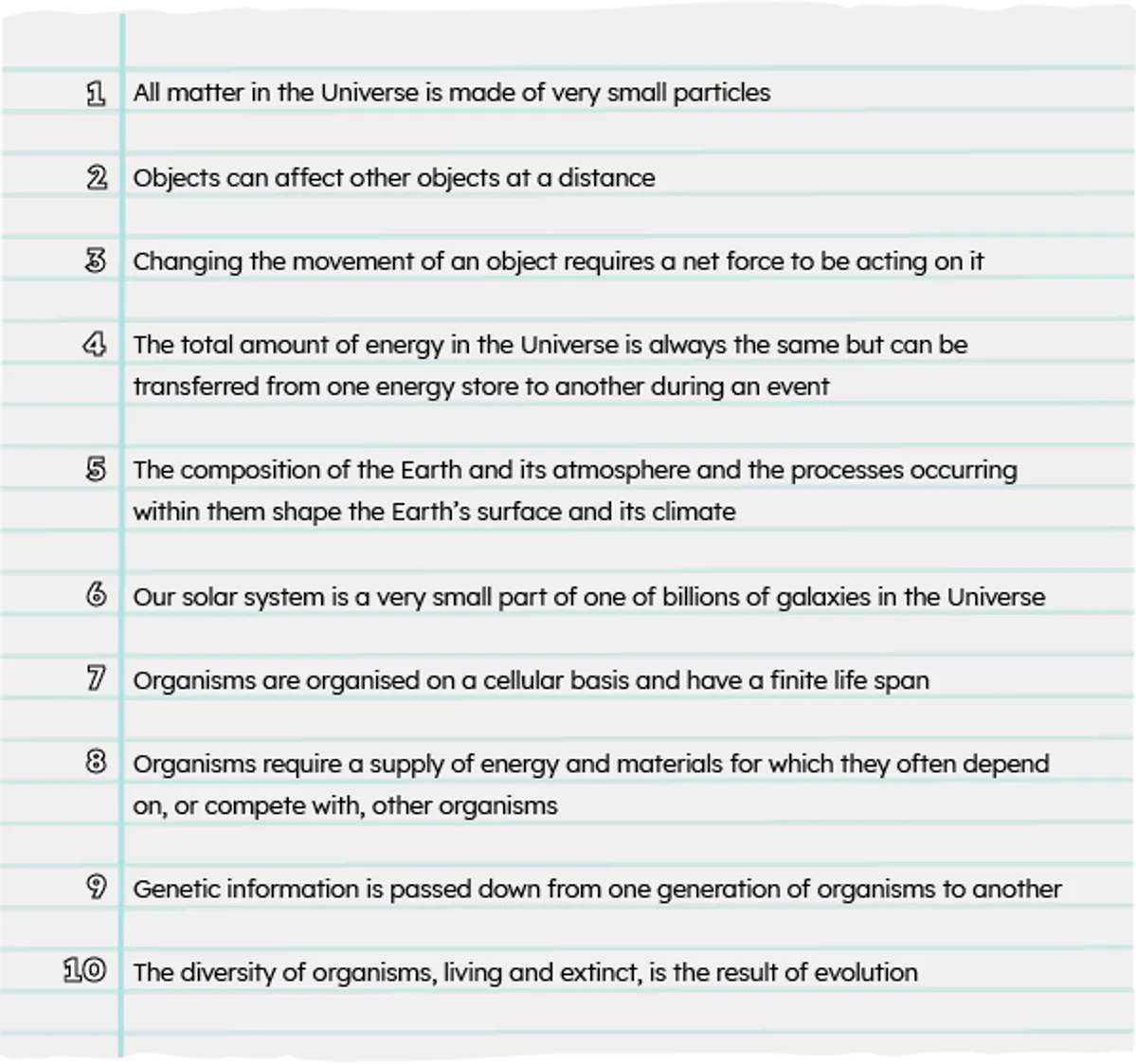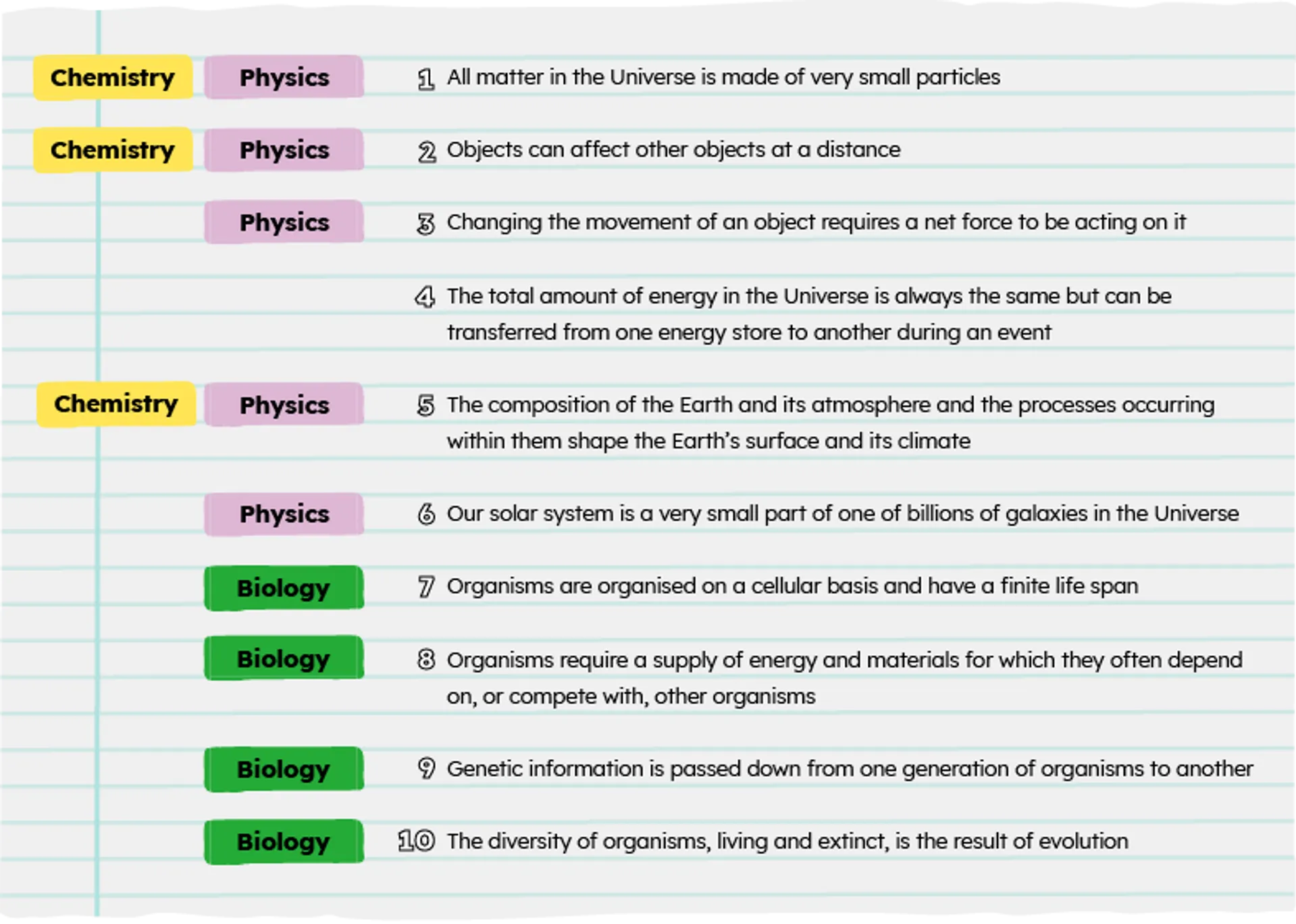
Categories
Curriculum planning
15 June 2023Exploring ‘big ideas’ through ‘big questions’ in science

Elisabeth Pugh
Subject Lead (science)
Earlier this year, we explained our approach to curriculum and that we have started developing brand-new curricula with our partners.
Here we will give you a behind-the-scenes look at the initial stages of the development of our primary and secondary science curriculum, in partnership with the University of York, through the University of York Science Education Group (UYSEG) and the Centre for Industry Education Collaboration (CIEC).
We also shared our science curriculum principles, one of which is using a ‘big ideas’ approach to science. In this blog, we’ll explore exactly what that means for our science curriculum.
View our new primary and secondary science curriculum plans and browse our resources.
Developing our science curriculum
A school science curriculum encapsulates what young people are expected and entitled to learn while at school. A good science curriculum is knowledge-rich – with so many facts and explanations explored through a multitude of engaging contexts, there’s a lot to learn. But if we could boil all that knowledge down to a list of ‘big ideas’ that we think pupils should know something about by the time they leave school, what would they be?
What are ‘big ideas’?
“A ‘big idea’ has broad explanatory power – it is widely applicable and helps us explain a great deal of what we observe in the world around us. Identifying a set of ‘big ideas’ to be developed through the school science curriculum is therefore useful, but not a trivial task.”
Alistair Moore, University of York Science Education Group
Various thinkers have tried to come up with sets of ‘big ideas’ of science education. A well-known list was produced by Wynne Harlen and her colleagues in 2010 (1), and updated in 2015 (2). Harlen’s ‘big ideas’ of science are:

Harlen’s 10 ‘big ideas’ of science have been widely discussed since their publication, as has the notion of using them to organise school science curricula . However, creating a science curriculum around these ‘big ideas’ is not as straightforward as it might initially appear.
Challenges of creating a ‘big ideas’ science curriculum for ages 5-16
A challenge arises when starting to apply Harlen’s ‘big ideas’ to our secondary school subjects of biology, chemistry and physics, as illustrated by the image below.
Harlen’s 'big ideas' work least well for chemistry, with insufficient granularity to usefully organise our chemistry curriculum content. 'Big idea' #4, about energy, would be developed across many different units in physics, chemistry and biology.

Much more problematically, and in agreement with our curriculum partners, we don’t see the ‘big ideas’ as being pupil friendly. By their nature, each ‘big idea’ is too big to teach all at once.
To develop children’s understanding of a ‘big idea’, it’s necessary to explore a series of smaller concepts in a particular sequence with specific vocabulary through the curriculum and to express each big idea succinctly, we have to use some specific scientific vocabulary. For these reasons, some of the ‘big ideas’ aren’t suitable for primary-aged pupils.
This thinking led the teams at UYSEG and CIEC to form their own take on ‘big ideas’ when developing our new science curricula.
“If we take the ‘big ideas’ and re-express them as a set of ‘big questions’ they work rather better at all stages of the curriculum. We've created a set of ‘big questions’ that are worded with a deliberate simplicity, so that they can be asked by anybody at any stage of the curriculum. Importantly, answers to the ‘big questions’ can be explored in an age-appropriate way at every level from KS1 to 4 or beyond.”
Alistair Moore, University of York Science Education Group
Using ‘big questions’ as threads
Familiar teaching units help to develop answers to each ‘big question’. Teachers and pupils will be able to explore an age-appropriate answer to the question through the units at every key stage, and the answer becomes more detailed and developed at each successive stage.
The units that build up an answer to each big question form a thread that runs through the curriculum from KS1 to KS4, and the thread functions as a pathway for learning progression.
Now we end up with ‘big questions’ such as ‘What are things made of?’ and ‘Why are there similarities and differences between living things?’; questions that could be answered by a KS1 pupil but could also be answered with more complex supporting evidence by a KS4 pupil.
An example: exploring the big question 'Why are there similarities and differences between living things?

We'll explore this example in more detail in forthcoming communications, but hopefully the summary in the image begins to demonstrate how there is both progression and coherence in a thread of units that, in both primary and secondary science, builds and expands an age-appropriate answer to the ‘big question’*. As you can see, one ‘big question’ really does lead to a whole wealth of learning opportunities!
“We hope our ‘big questions’ provide a useful framework for thinking about and organising the school science curriculum in a way that makes sense in both primary and secondary. We hope that by organising units into threads that build answers to ‘big questions’ we can help improve progression, coherence and transition between key stages, and between primary and secondary.
"And we hope that approaching a unit through the lens of a ‘big question’ might help pupils to better appreciate the relevance and purpose of studying it. But one of the core principles of Oak’s curricula is flexibility, so while the ‘big questions’ are intended to be a useful tool to aid your curriculum thinking, each of our lessons and units can be used within your own scheme of work, if you prefer. The power is yours.”
Alistair Moore, University of York Science Education Group
We are looking forward to sharing our new models of high-level, long-term planning sequences of what is taught and when in science, and models of how this can be broken down into units in the autumn.
Sign up for updates on our new science curriculum
Sign up below to be kept updated on our latest curriculum developments, get updates when new resources are available and receive other helpful content by email. Unsubscribe at any time. Read our privacy policy.
Sign up for Oak updates
(1) Wynne Harlen, ‘Principles and Big Ideas of Science Education’, 2010
(2) Wynne Harlen, ‘Working with Big Ideas of Science Education’, 2015
*Please note that there may be some slight changes to the draft unit titles shown prior to release of the full curricula sequence in autumn

